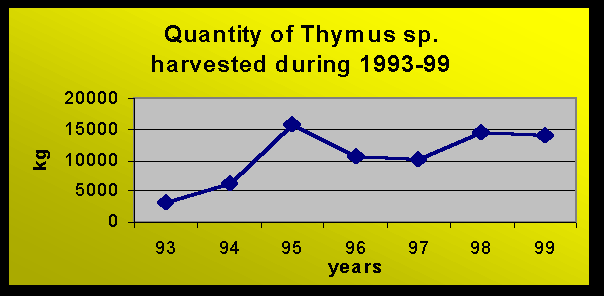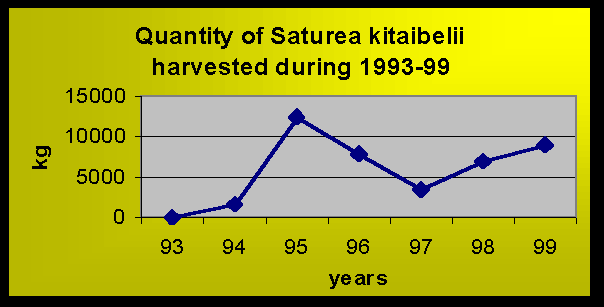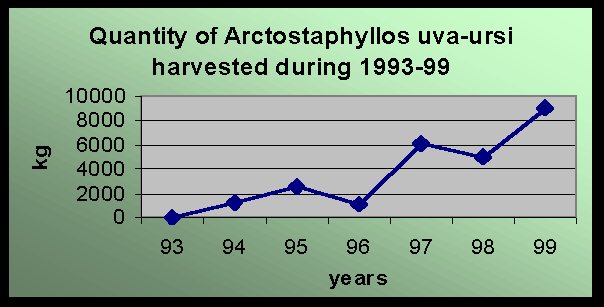Graph 1.

Since 1993 in Serbia the harvesting of commercially important medicinal plants have been legally regulated for the protection of native population from its excessive harvesting. It includes 129 original plant species whose annual harvesting is regulated by the law and permits for their harvesting are required as well. Until 1999, 73 plant species were under the harvesting control.
The analyze of the issued number of permits during the last seven years (1993 - 1999) shows that 50 plant species have been harvested in Serbia. A greater oscillation per each year has been noticed concerning the total amount of the demand as well as in the amount per each species. For some medicinal plants such as bearberry (Arctostaphyllos uva - ursi) the demand at the market exceeds the nature potential. There is a group of medicinal plants for which the permits for their harvesting from their habitats have not been applied, they are not being cultivated, but it has been distinguished that they have been exported in large amounts, for example gentian yellow (Gentiana lutea), and spotty gentian (Gentiana punctata). This situation indicates the necessity of large-scale cultivation of the most threatened and the most demanded species, insufficiently stable market, as well as the presence of illegal trade and harvesting.
In 1999, because of the NATO attacks the harvesting was not limited and the demand of the species helped in estimating of a real harvesting.
The harvesting of medicinal plants in Serbia has a long tradition. In the last fifty years due to increased demand, the exploitation of medicinal plant species in their natural habitats has been abruptly intensified. The increased utilization of natural resources has caused the concern about survival of species, followed by the necessity for their protection. The legal measure for protection and conservation of original medicinal plants has been regulated by the Law of Environmental Protection, which directly or indirectly arranges the species protection and the regime of protection. Since 993 in Serbia the harvesting of commercially significant plant species has been legally regulated in order to protect natural populations from the over - exploitation. By republic legal act in the field of conservation of nature "Naredba o kontroli korišćenja i prometa divljih biljnih i životinjskih vrsta ("The Order on Control of Trade and Utilization of Wild Plant and Animal Species") ("Sl. Glasnik RS " - "Serbian Official Register", No. 50/93, 16/96, 44/96 and 17/99). Legal measures for harvesting utilization and trade in original medicinal plants which have become endangered by uncontrolled utilization or whose habitats have become endangered are given. The way of recording of data on harvested species has been defined. The harvesting is possible in the amount that has been allowed and in the way, which insures the conservation of their populations, structure and stability of plant communities in the region of harvesting, which means that the survival of protected species is not endangered. For some species the harvesting is forbidden at certain regions or on the whole territory of Serbia during the period of one or more years depending on the state of the population. There are 129 original plant species, for which the Institute for Protection of Nature of Serbia issues harvesting permits. Until 1999, 73 species were under the harvesting control.
On the basis of the annual reports made by the Institute concerning the medicinal plant species for which permits for taking in the wild have been issued, in the period between 1993 and 1999, the statistics analyze about the number of species and their amount per each year has been done. The parallel analyzes and histograms have been made according to excel. Data on export and import of medicinal plants in our country given by Federal Institute for Statistics, have been analyzed and compared to date on harvesting.
According to the analyze of the permits issued during the last seven years (1993 - 1999) in Serbia 50 plant species are being harvested. During that period 10.683 t of medicinal plants were harvested (Graph 1).

According to the issued permits the largest amount of medicinal plants was harvested in 1993 (3. 304 t) then in 1995 (2.770 t). The least amount was harvested in 1994 (456 t) and in 1997 (661 t). The harvesting in 1996 (1.163 t), in 1998 (1.075 t) and in 1999 (1.254 t) show the same degree of utilization from natural habitats. In 1999 by the new Order, the list of medicinal plants whose harvesting and trade is subject to legal control has been enlarged. The species analysed since 1993 have been harvested in the amount of 1.081 t in 1999, while the new listed species have been demanded in the amount of 1.729 t. This justifies the enlargement of the listing species. In 1999 by the Decree of the Minister for Environment Protection the amount and the regions of harvesting were not limited. Data from 1999 may picture the real estimate of the amount being harvested but on the other hand because of NATO air attacks it is possible that many pickers did not work.
The drastic decrease in the amount of harvested plants in 1994 and 1997 is explained by market changes and the presence of illegal trade. The harvesting in 1996, 1998, and 1999, are equalized. The changes in the amount per each harvested species from that period are also evident, depending on market situation, caused by limiting or total prohibition of harvesting at certain regions or on the whole territory of Serbia. The species whose harvesting oscilate are the folowing: yarow (Achillea clypeolata), common agrimony (Agrimonia eupatoria), deadly nightshade (Atropa belladona), charline thistle (Carlina acaulis), autumn crocus (Colchicum autumnale), rupturewort (Herniaria glabra), majoran (Origanum vulgare), lungwort (Pulmonaria officinalis), blackberry (Rubus ulmifolius), winter savory (Satureja kitaibelii) and common St. John's Wort (Hypericum perforatum).
The harvesting of common St John's Wort oscilates (Graph 2), the drastic increase (159.570 kg) was evident in 1999 when the amounts for harvesting were not limited. The amount being harvested significantly exceeds quotas determined at the beginning of the year. The decrease in number of natural populations of this species is caused by nonprofessional harvesting and uprooting of the plant.

Recently the large scale cultivation has caused the decrease in interest for natural populations of some species. Some of them are: sage (Salvia officinalis), queen cell Mellisa officinalis) and valerian (Valeriana officinalis) (Graph 3). In Serbia, sage grows originally only at Sićevačka klisura (gorge), and is successfully large scale cultivated. Because of that it is not on the list of the new Order, but it is nominated for protection as a natural rarity, which means that its harvesting is totally forbidden. The analyse of data shows the decrease in harvesting from natural habitat which is due to large scale cultivation and harvesting of this species in Monte Negro.
The analyses of some species (marsh mallow - Althea officinalis, common St. John's Wort - Hypericum perforatum, thyme- Thymus sp., winter savory - Satureja kitaibelii) which are harvested in wild and are large scale cultivated, show great pressure on natural populations (Graph 4). Therefore it is necessary to increase the large scale cultivation area in the following period.



The greatest problem for the protection represent the endangered species which are exclusively taken from the wild,such as bearberry (Arctostaphyllos uva-ursi), the species which is listed on the Serbian Flora Red Data List. This endangered commercial species is taken from wild more and more, which imperils its survival. Therefore it is necessary to acquire growing technology of this species, because natural populations may become extinct due to such intensive harvesting (Graph 5).

The analyses of data concerning import and export of medicinal plants (1991- 1997) done by Federal Institute of Statistics shows that 20 t of gentian were exported in 1997. The species is exclusively harvested from its natural habitats, and in this period no permits were required. In previous years the species was not imported, except for 1 t in 1997 from Albania, nor it was officially harvested in Serbia, which points to the presence of illegal trade.
279 medicinal plants are subjects of trade, while the harvesting of 129 plant species is being controlled, and official permits have been issued for fifty species. The main threatening factors are: excessive and uncontrolled harvesting, inexperience and non-profession of the pickers, such as an unintentional confusion between similar and akin species. The lack of data is a problem for planning and implementation of active protection measures. Some species are also endangered because the harvesting is limited or prohibited in many European countries (the importing ones), which causes the higher pressure on the natural resources of our country.
The special problem represents bilberry (Vaccinium myrtilus) because of the harvested quantities and devices of harvesting by special combs or rakes which are legally forbidden because they damage and destroy the whole plant. In 1993 the largest amount was harvested then drastic decrease occurred. In 1997 the permits were issued only for 6.500 kg of bilbery on the whole territory of Serbia, and it is estimated that it is not the real harvested amount. Bilberry is exported both as raw material and as refined one (juices, teas, jams), so it is not necessary to register it with National Bank of Yugoslavia, which lessens the possibility of control. The supervision of Inspection of Ministry of Environmental protection in the harvesting period of bilberry led to the increase in quantities for which the permits were required and issued.
Sustainable development, which means the conservation of biodiversity, is the main aim of the policy for the protection of the environment. This includes the conservation of natural resources, their rational utilization and permanent implementation of legal measures and conservation programs.
By controlled harvesting and trade in commercially significant medicinal species the "in situ" protection is insured, and at the same time it stimulates the "ex situ" protection by large-scale cultivation.
It is expected that in following years the harvesting of medicinal plants will be at the same level or have tendency of increasing, until the areas for large scale production get enlarged and until the growing technologies of commercially most demanded and most endangered species are acquired. After that stagnation followed by a lower pressure on natural populations is expected. It is necessary to enlarge large-scale cultivation of marsh, Common St.John's Wort, Thyme, winter savory, and to acquire the technologies of growing of the endangered species (Gentiana lutea, Arctostaphyllos uva - ursi).
Amidžić L., Dražić S., Kostić M., Maksimivić S., Mandić R., Menković N., Panjković B., Popov V., Radanović D., Roki Đ., Sekulović D., Stepanović D., Tasić S. (1999): Strategija zaštite lekovitog bilja u Srbiji. Ministarstvo zaštite životne sredine Republike Srbije.
Naredba o kontroli korišćenja i prometa divljih biljnih i životinjskih vrsta. "Službeni Glasnik Republike Srbije", broj 50/93, 16/96, 44/96 17/99.
Godišnji izveštaji Zavoda o dozvoljenim količinama sakupljanja za 1993, 1994, 1995, 1996, 1997, 1998 i 1999 godinu.